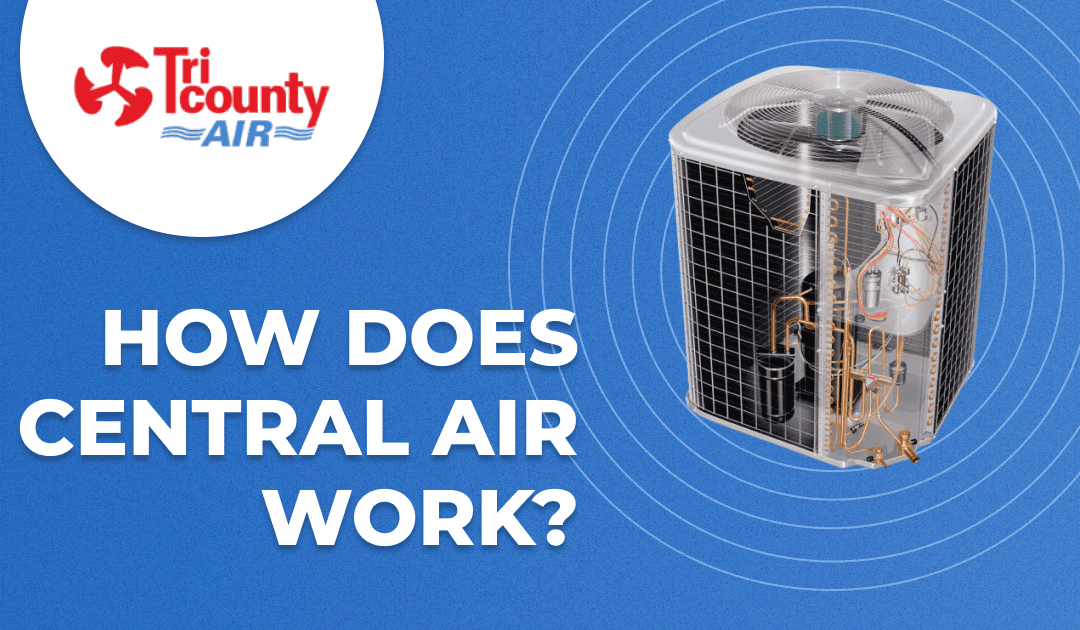In its modern form, air conditioning has been around since 1902. Willis Carrier’s invention has been improved and modified over the years, leading to many cooling options today. But split-system air conditioning (or “central AC”) is still the most popular. Aside from air temperature, it can control humidity, airflow, and air quality. Continue reading for a more in-depth look at the answer to the question, “How does central air work?”
Parts of a Central Air Conditioning System
Together all the system’s components provide cool air to your entire home, unlike a window AC or mini-split unit that serves a single room. To help you understand how a central AC system works, here’s a look at some of its major parts:
- Outdoor Unit: A casing that houses the compressor, condenser coil, and fan, it sits on a concrete pad next to an outside wall.
- Indoor Unit: Includes the evaporator coil and fan that circulates air throughout your home; it’s usually a furnace or fan coil.
- Ductwork: Connects the indoor unit to registers/vents in rooms and living spaces, allowing conditioned air to circulate.
- Copper Tubing: Provides a conduit for refrigerant, in vapor and liquid form, to flow between the outdoor and indoor units.
- Thermostat: Reads room temperature and controls the system based on whether air temperature matches set thresholds.
How the Process Works
Here’s a simple view of how central air works. Warm air blows across a cold coil inside your home. The cold refrigerant absorbs heat from the air and becomes a gas. Colder air is then blown back into the house. On the outside, gaseous refrigerant is compressed as it enters the outdoor unit’s coil. As the refrigerant converts back to a liquid, heat is released. A fan directs the heat away by pulling outdoor air through this coil.
A more detailed look at the central air conditioning process is as follows:
The Thermostat Sends a Signal to the AC
Usually mounted on a wall in a centralized area, the thermostat constantly senses air temperature. When the ambient indoor temperature rises above what you set on the thermostat, it automatically sends a signal to a circuit board.
The Blower Motor Starts Running
Electricity starts flowing so the blower motor can turn on. The fan in the indoor unit starts pulling hot air from inside the house. As air flows through return air ducts, it is filtered, removing dust, lint, and other particles and pollutants. Meanwhile, the outdoor condenser starts to run.
Air Passes Over the Evaporator Coil
Filtered, warm air passes over the evaporator coil, through which liquid refrigerant flows. The heat from the air is absorbed by the refrigerant, causing it to turn into a gas. Cooled air blows through air ducts to vents in each room. Meanwhile, a condensate pan picks up excess moisture that flows into the drain line to the outside unit.
Refrigerant Gas Is Sent Outside
A copper tube delivers gaseous refrigerant to the compressor, which pressurizes the gas. The heat is evacuated via coils or metal fins and dissipated by a compressor fan. As the heat is released outside, the refrigerant turns back into a liquid.
Refrigerant Returns to the Indoor Coil
Coolant returns inside through a copper tube. An expansion device controls how much refrigerant flows back to the evaporator coil. Cold refrigerant can then absorb more heat from your home in a continuous cycle. The process continues until the system achieves the desired temperature, at which point the thermostat will cycle the system off.
Types of Central Air Conditioners
The most common type is the split central AC. Indoor air handlers and outdoor units contain most of the system’s components. The evaporator coils are near the air handler or furnace. Packaged central air conditioners work similarly, except all components are in one unit; which pumps warm air from inside and returns cooled air in exchange. Usually installed on the ground, a packaged unit may also be roof-mounted.
Tri County Air Has Your Central AC Needs Covered
The question “How does central air work?” is fully understood by our licensed HVAC technicians, who can install and fix any make or model of unit. Since 1977, we’ve provided a wide range of HVAC services for residential and commercial clients in Charlotte, Manatee, and Sarasota Counties. If your central AC isn’t working or it’s time for maintenance, we’re here to help. We provide 24/7 emergency service and a 100% satisfaction guarantee. For more information about central AC and other HVAC topics, visit our Learning Center. Request your appointment online or call (941) 485-2222 for prompt service!

